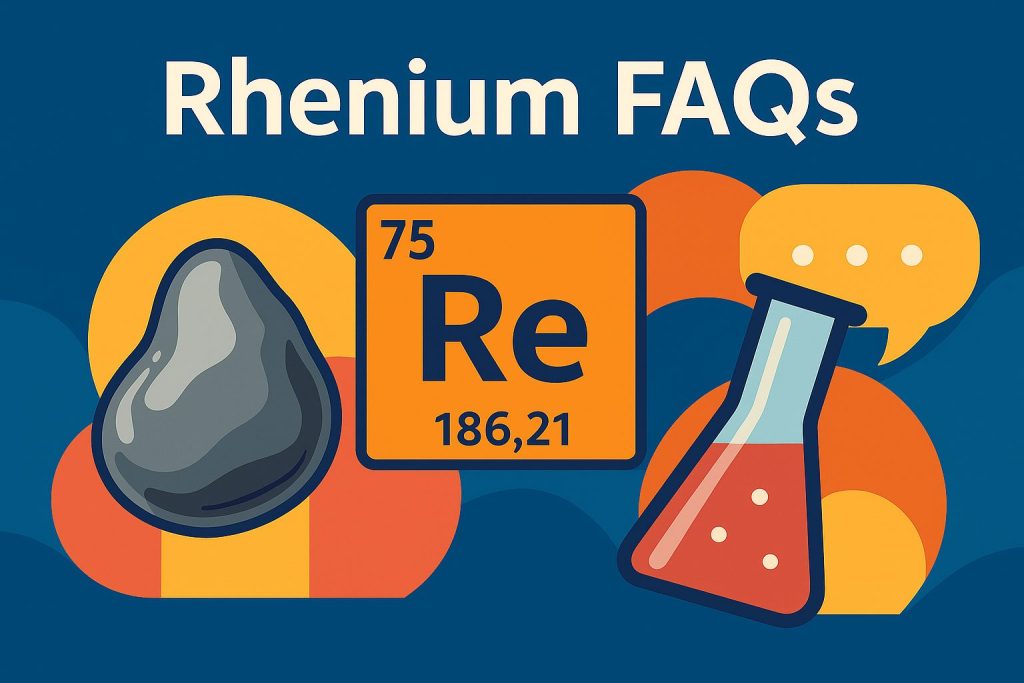The Heat-Resistant Heavyweight That Powers Jet Engines and Portfolios

Whether you’re fascinated by high-performance alloys or curious about the world’s rarest metals, rhenium is a material worth knowing. With a melting point that can rival a volcano and applications ranging from aircraft turbines to catalysts in petrochemical refining, this unsung element quietly powers modern industry.
In this FAQ, we dive into the fascinating properties, origins, and uses of rhenium and explore why it’s attracting growing interest from savvy investors.
🔬 Properties & Physical Behavior
Rhenium is a rare, silvery-grey transition metal known for its extreme resistance to heat and wear. It boasts one of the highest melting points of all elements, second only to tungsten, making it indispensable in high-performance alloys.
In its pure form, rhenium is a dense, silver-grey metal with a lustrous sheen. It often appears as a fine powder or in compacted pellet form when sold commercially.
Rhenium’s melting point is 3,186 °C (or 5,767 °F). This exceptional heat resistance is precisely why rhenium is highly prized in jet engines, gas turbines, and other environments with extreme temperatures.
Rhenium is remarkably inert under normal conditions. It resists corrosion and doesn’t oxidise easily, even in air. However, at high temperatures, it can react with oxygen to form rhenium oxides.
📖 History & Discovery
Rhenium was discovered by German chemists Ida and Walter Noddack, along with Otto Berg. They named it after the Rhine River (Latin: Rhenus), which is located near their research base.
Rhenium was first isolated in Germany in 1925. While its existence had been theorised decades earlier, it wasn’t until spectroscopic analysis improved that it could be identified conclusively.
Rhenium’s atomic number is 75, and it sits in group 7, period 6 of the periodic table, just beneath manganese and technetium.
🌍 Origin & Production
Rhenium is one of the rarest stable elements in the Earth’s crust. It never occurs as a standalone mineral and is only found in trace amounts within ores of molybdenum and copper, making its extraction both difficult and expensive.
Rhenium is primarily extracted as a by-product during the processing of molybdenum and copper ores. Major producers include Chile, the United States, Kazakhstan, and Poland.
Rhenium is typically recovered from flue dust during the roasting of molybdenite concentrates. It’s then refined through complex chemical extraction processes, often involving ammonium perrhenate.
The United States holds some of the world’s largest rhenium reserves, primarily associated with copper mining operations in states such as Arizona and Utah. However, production is still relatively modest due to the metal’s rarity.
⚙️ Uses & Applications
While you won’t find rhenium in your kitchen drawer, it plays a vital role behind the scenes: in jet engine turbines, petrochemical refining, and X-ray machines. It’s one of the key enablers of modern aviation and energy systems.
Rhenium is found in superalloys for jet and gas turbines, catalytic converters for oil refining, and
thermocouples and filaments in high-temperature scientific equipment.
Several factors contribute to rhenium’s high price:
– It’s one of the rarest elements on Earth.
– It cannot be mined directly.
– Its use in critical aerospace and energy infrastructure ensures constant demand.
– No known substitutes exist for its high-temperature properties.
🧪 Safety & Handling
Rhenium is generally considered non-toxic and biologically inert in its metallic form. However, some rhenium compounds, such as rhenium oxides, can pose health risks if inhaled or ingested, so standard handling precautions apply.
No, naturally occurring rhenium is not radioactive. It is one of the rare elements with only stable or extremely long-lived isotopes, making it safe for industrial use.
💼 Buying, Investing & Storage
Industrial-grade rhenium isn’t something you’ll find on Amazon. If you’re considering physical ownership of this metal, it’s best to purchase from a specialised supplier. At Strategic Metals Invest, we offer high-purity rhenium in investor-ready form, complete with ISO-certified documentation and optional secure storage.
You can invest in rhenium by physically owning it, either individually or as part of a diversified basket of strategic metals. At Strategic Metals Invest, we offer tailored solutions for investors, including secure storage in Frankfurt’s METLOCK vault, professional-grade packaging, and easy resale options to industrial buyers.
Rhenium is stable in air, but due to its value and industrial demand, we recommend professional storage. Our METLOCK facility in Germany offers high-security vaults with comprehensive insurance and optimal preservation conditions for long-term storage.
Rhenium may not be a household name, but its role in modern technology is absolutely critical. From enabling jet engines to pushing the boundaries of material science, this rare and resilient metal is gaining attention in both industry and investment circles. If you’re looking to diversify with a tangible asset that’s as scarce as it is strategic, rhenium might just be the heavyweight metal your portfolio has been missing. Contact us for more information.


